Spain Geospatial Imagery Analytics Market Size
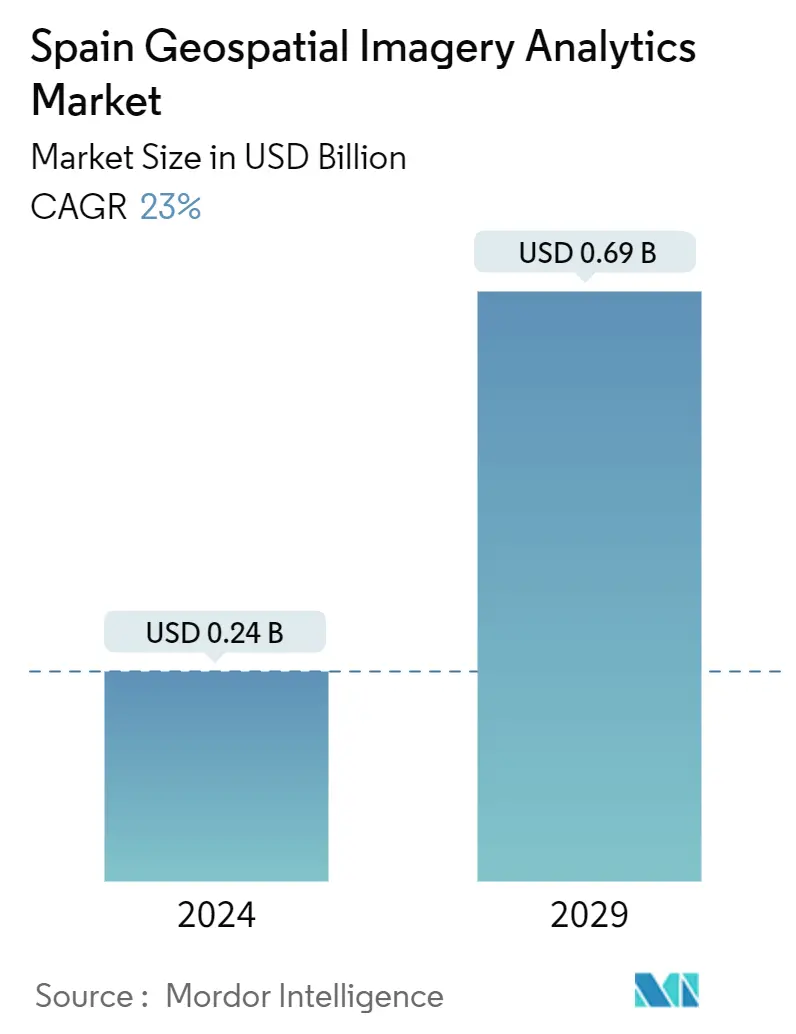
| Study Period | 2019-2029 |
| Base Year For Estimation | 2023 |
| Market Size (2024) | USD 0.24 Billion |
| Market Size (2029) | USD 0.69 Billion |
| CAGR (2024 - 2029) | 23.00 % |
| Market Concentration | Medium |
Major Players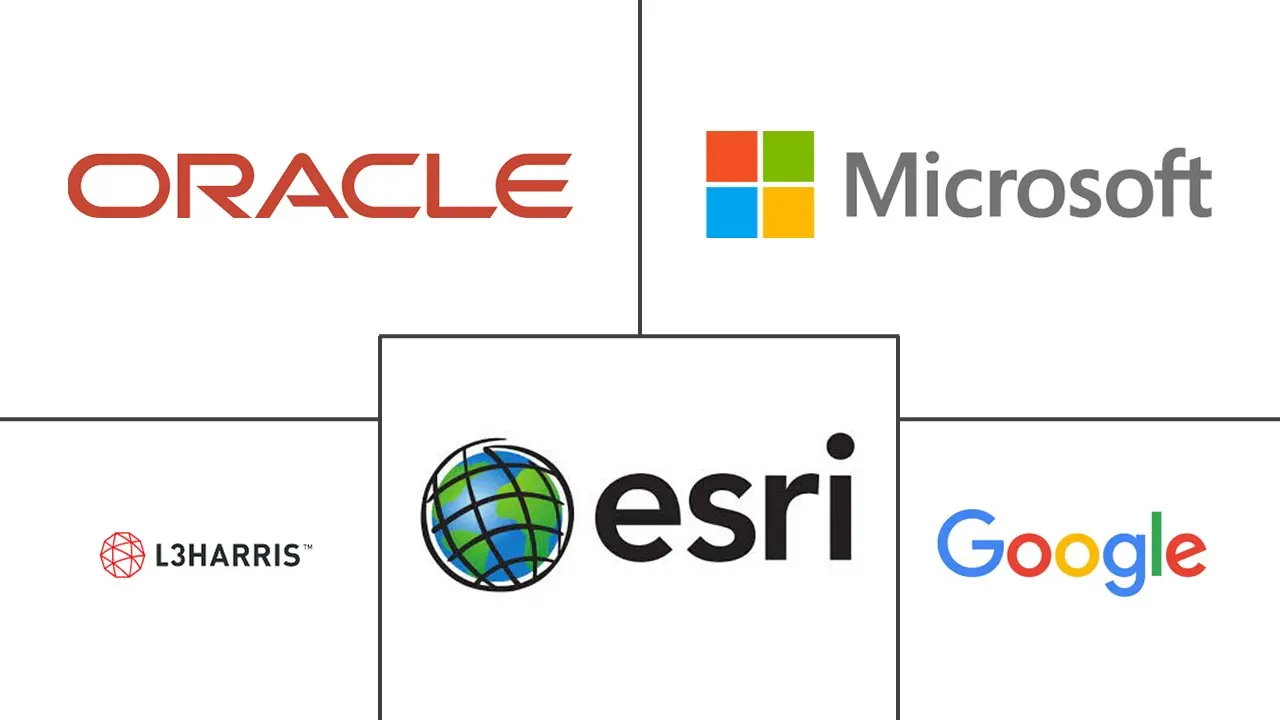
*Disclaimer: Major Players sorted in no particular order |
Spain Geospatial Imagery Analytics Market Analysis
The Spain Geospatial Imagery Analytics Market size is estimated at USD 0.24 billion in 2024, and is expected to reach USD 0.69 billion by 2029, growing at a CAGR of 23% during the forecast period (2024-2029).
Geospatial imagery analysis refers to a broad range of activities that emphasize applying various techniques to data comprising geographical or space-related characteristics. Some of the key factors driving the growth of the geospatial imagery analytics market include the increasing technological advancements in the field of GIS technology, recent trends in integration and convergence of geospatial technologies, the advent of new business models aimed at leveraging the demand for geospatial information, and increased application of geospatial analytics in city and town planning.
- The analysis of satellite or aerial photographs to generate significant information about the Earth's surface is done by geospatial imaging analytics. This technology is critical in many parts of mining operations, resulting in enhanced efficiency and safety. For instance, it allows mining companies to precisely assess mining conditions by offering a whole perspective of the location, which includes topography, terrain, vegetation cover, and infrastructure. Companies can improve safety and reduce accidents by analyzing this data, identifying possible dangers, and taking proactive efforts to mitigate them.
- Geospatial technology can provide extensive insights into a city's physical environment, infrastructure, and assets, allowing for more effective planning and decision-making. Higher frequencies, which are necessary for 5G networks, have a limited range and are prone to interference from various things. This data may be utilized to optimize the location of 5G infrastructure, resulting in higher network coverage and fewer signal disturbances. Several governments seeking to attract foreign direct investment have prioritized the development of 5G technology and infrastructure. Geospatial technology is critical in advancing these efforts, notably in developing smart cities.
- In March 2023, Esri announced a web-based mapping application built on the ArcGIS API for JavaScript for considering and analyzing global land-cover changes. Sentinel-2 Land Cover Explorer, the app, delivers Esri maps, image services, spatial analysis tools, and ESA Sentinel-2 imagery at 10m resolution. All these elements are combined and offered in a browser-based application that can be without additional software or login credentials.
- On the contrary, the legal and regulatory issues surrounding the usage of geospatial imaging analytics technologies are difficulties that stem from a variety of issues, including regional variations, location privacy concerns, intellectual property rights, data licensing, and geographical data storage. One of the key limits is the regional variation in data collection techniques. Geospatial imaging analytics is strongly reliant on current and reliable data, such as satellite images and aerial pictures. Access to such data, however, might be limited in particular locations or nations, making it difficult for geospatial technology suppliers to collect complete and consistent data for analysis.
- Demand for geospatial analytics applications, such as those used in tourism and transportation, decreased due to COVID-19. The production facilities were also closed, which made it more challenging to supply and regulate electrical components. However, the pandemic increased the demand for public health applications, emergency response applications, and environmental monitoring applications, which in turn are used to track the spread of COVID-19 and identify areas at risk.
Spain Geospatial Imagery Analytics Market Trends
Cloud Segment is Expected to Hold a Significant Share of the Market
- There are various reasons and financial benefits for organizations to have their analytics on the cloud. Some of them are the 24x7 availability of the cloud environment without any infrastructure dependency, the reduction of the time taken to deploy BI (business intelligence) components, the flexibility of scaling up or scaling down the infrastructure based on the requirement, the cost-effectiveness in terms of infrastructure procurement, and the massive spending on license and the support of mobile and web-based remote access to control database access, ensure user security, and perform analytics.
- Knowing the Total Cost of Ownership (TOC) of the A&BI platform is a significant consideration. A cost comparison that examines the internal costs of infrastructure licensing and authorization compared with external hosting in the cloud must be assessed. With SaaS, the total cost of ownership is typically lower due to several factors. First, some SaaS solutions are multitenant platforms that allow several users to share the software's underlying infrastructure. Users retain private and separate information even though it could be a shared platform. Second, SaaS analytics and BI platforms can get the business's servers, hardware, or IT resources to get the software up and running.
- Because SaaS analytics platforms are automated and ready to use, they have significantly less implementation time- typically a matter of days. SaaS is accessible via standard web browsers, resulting in reduced understanding curves and higher adoption rates. Because SaaS solutions are intuitive, self-service, and approachable, they are accessible to all users. On the other hand, implementation of on-premise A&BI (artificial and business intelligence) infrastructure generally takes months and requires employees trained to extract insights. Such advantages of cloud solutions over on-premise solutions are expected to drive cloud deployment significantly.
- However, IT professionals have significant concerns about the security of cloud solutions as most vendors have more substantial resources available to invest in security than a general business and provide a much higher level of security than the business could give itself. As a vendor automatically backs up data, there is a better chance of disaster recovery. However, every enterprise is different, so it is necessary to know the risk tolerance of the vendor. On-premise platforms are typically seen as less risky, which is expected to hinder the growth of cloud solutions.
- According to the European Space Agency, In 2022, Spain will contribute over EUR 220.7 million (USD 232.7 billion) to the European Space Agency (ESA) to support the mission of ESA in space explorations. France was the largest contributor during that period, with over EUR 1.1 billion (USD 1.16 billion). Such huge spending by the Spanish space agency would push the demand for the studied market.
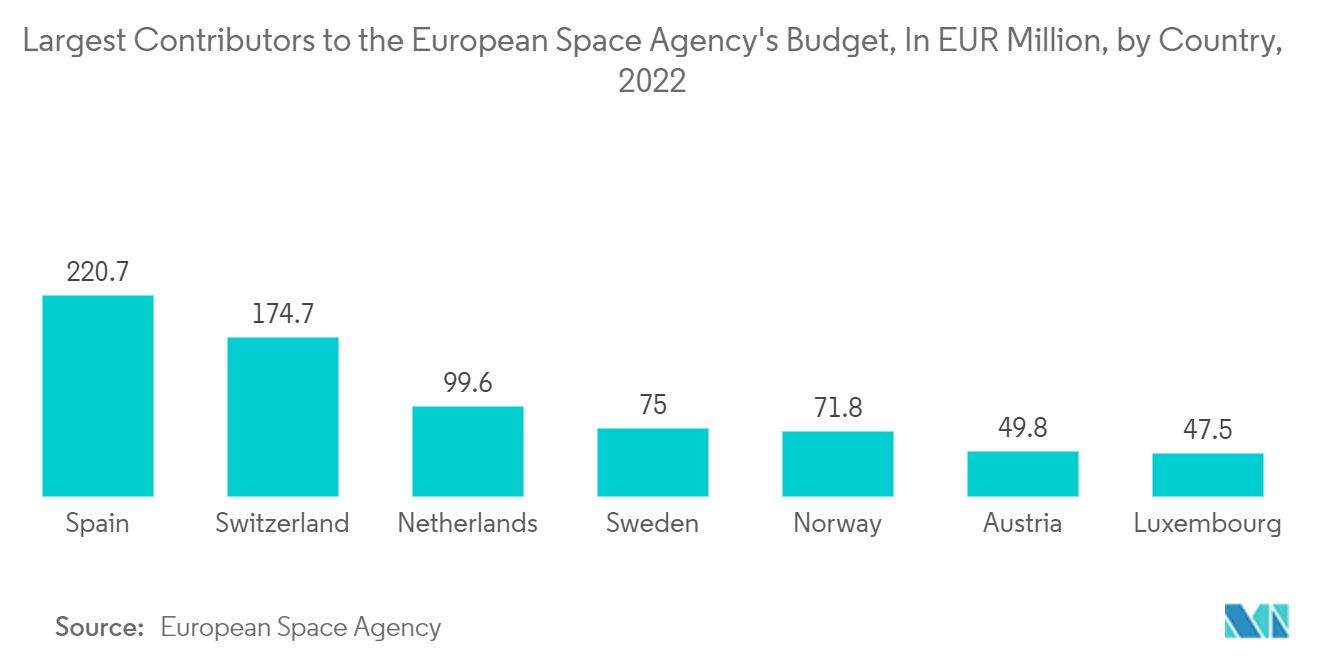
Defense and Security is Expected to Hold Significant Share
- Earth observation using high-resolution satellite imagery has long been a source of information for significant and urgent national security and defense concerns. Earth observation technologies are beneficial for monitoring land and sea borders in remote and isolated areas. It is possible to analyze vast sets of historical data and devise procedures to avoid border infractions at the regional and national levels using high-resolution satellite photos, aerial photography, and drones. Furthermore, technologies can be utilized to monitor large geographical areas and offer up-to-date information regarding infrastructure, logistics, and military installations in local conflicts. It's beneficial for assessing damage quickly in local conflict zones. Such things would drive the studied market.
- With rising marine traffic, border security enforcement, and increased illicit activities and hazards at sea, it is more critical than ever to properly monitor, respond, and defend our oceans and waterways. Pleiades Neo provides law enforcement agencies with a new level of maritime intelligence. We can now offer immediate insight for effective surveillance thanks to its 30 cm resolution comprehensive imagery and multi-visit capabilities. Pleiades Neo is useful for identifying illicit activities/routes, trafficking, oil spill monitoring, and illegal fishing in maritime security and environmental applications.
- Customers in the defense and intelligence sectors work in a challenging environment and require the most reliable and precise instruments to complete their missions. Companies are providing new services in their satellite imaging portfolio to meet those demands. For example, The four identical Pleiades Neo satellites, with 30 cm resolution, best-in-class geolocation accuracy, and twice-daily revisit, open up new possibilities: improved projection preparation, the precise location of enemy positions, and better anticipation and prevention for increased responsiveness and protection.
- GOVSATCOM is part of the EU Space Programme (2021-2027), which uses space’s capabilities in satellite communications to enable and facilitate the commission of Member States or EU policies connected to citizen security. In regions with no ground infrastructure (e.g., sea, air, rural areas, the Arctic region), or if the current ground infrastructure is unstable, damaged, or destroyed, access to GOVSATCOM is essential (e.g., due to natural disasters, crises, conflicts). This would create an opportunity for the market players to develop new products to capture the market share.
- According to NATO, in 2023, Spain's defense expenditure was estimated at USD 19.18 billion, the highest expenditure since 2014. In the previous year, the expenditure was estimated at USD 14.90 billion. Military expenditure is the money spent on a country's armed forces, including peacekeeping and defense operations. Such huge expenditure towards the military would propel the satellite imagery products, driving the demand for the studied market.
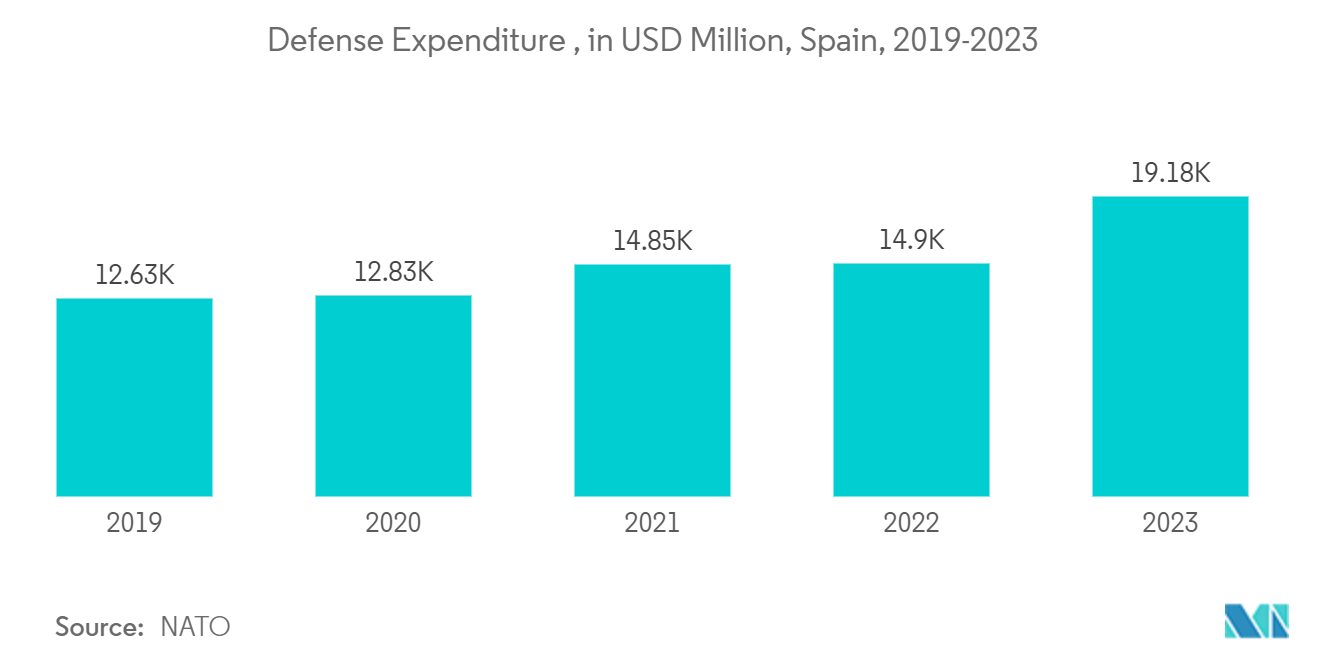
Spain Geospatial Imagery Analytics Industry Overview
The Spain Geospatial Imagery Analytics market exhibits a semi consolidated featuring several key players, including Google LLC, Microsoft Corporation, Oracle Corporation, L3 Harris Corporation, Hexagon AB, ESRI and many more. These companies are actively engaged in strategic partnerships and product development initiatives aimed at expanding their market presence.
In December 2023, Oracle Spatial Studio 23.2 is now available, including multiple user enhancements and behind-the-scenes improvements. Analysts can utilize the redlining tools to mark up maps, highlighting points of interest or marking unusual activities for further exploration. Users can use custom symbols to show their storefront locations using their logo instead of a generic icon. Developers may find the ability to embed Spatial Studio maps into external web applications interesting. The firm has added a native Web Component for embedding Spatial Studio maps into other applications.
In May 2023, CAPE unveiled its partnership with Google to further this mission and leverage structural attributes from Google’s aerial imagery and digital surface models (DSM) in its property intelligence platform and weather risk solutions. CAPE’s structural insights range from roof dimensions to wildfire and hurricane risk scores. Adding Google’s geospatial services to CAPE’s leading property intelligence platform creates a robust and powerful geospatial analytics offering explicitly built for insurance carriers. This partnership enables CAPE to provide insurance carriers with extended coverage and property information they require to mitigate risk and help prevent property damage proactively.
Spain Geospatial Imagery Analytics Market Leaders
-
Google LLC
-
Microsoft Corporation
-
Microsoft Corporation
-
L3 Harris Corporation
-
Hexagon AB
*Disclaimer: Major Players sorted in no particular order
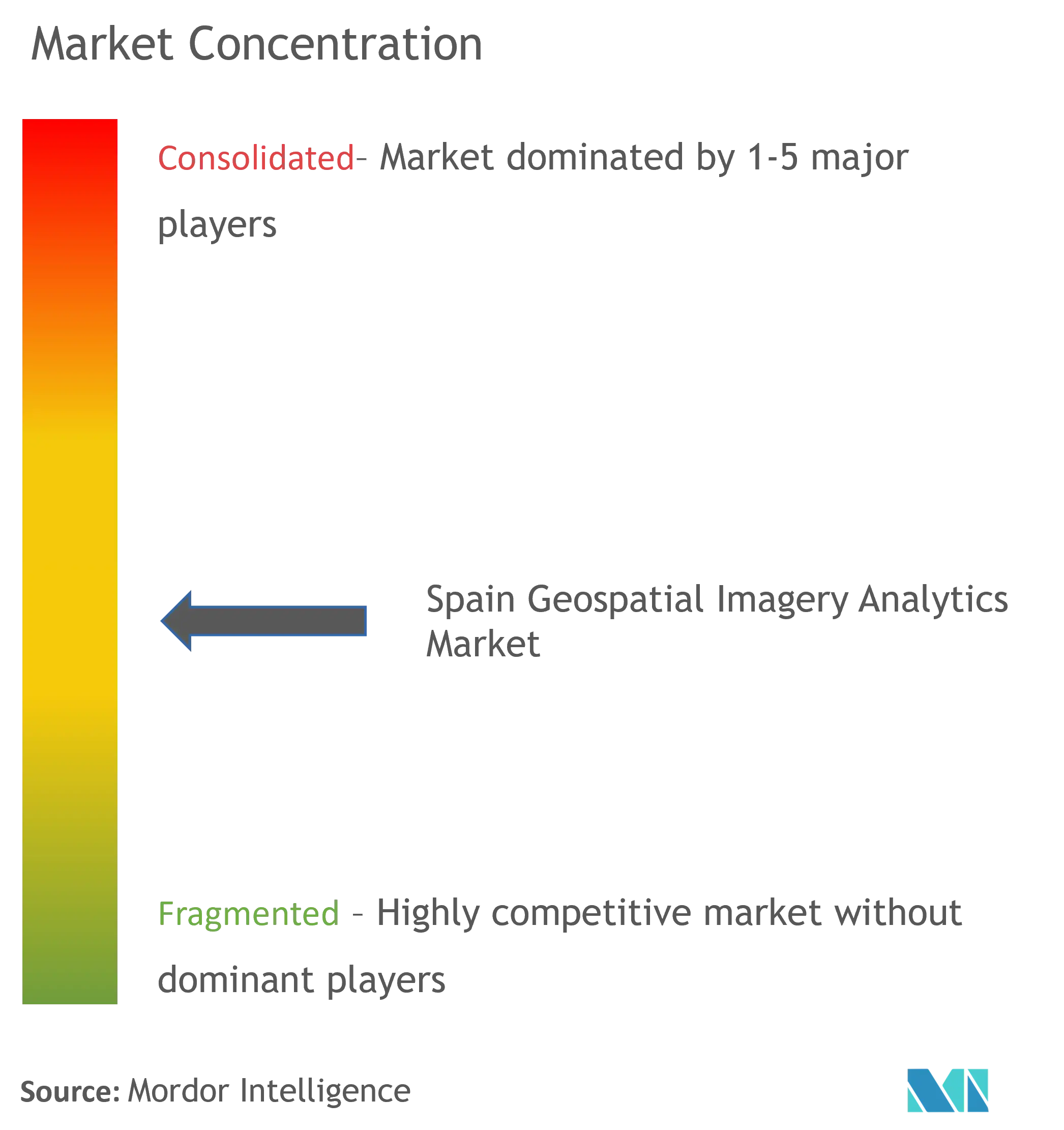
Spain Geospatial Imagery Analytics Market News
- July 2023: Databricks is the provider of a big data tool named Databricks Lakehouse Platform, which merges data science, data engineering, machine learning, and analytics within a single platform. To provide even more valuable insights to data scientists, spatial analytics is often added to the mix to put large amounts of data in the proper context. A new partnership with Esri brings advanced spatial analytics capabilities in Esri’s ArcGIS software to the Databricks Lakehouse Platform, allowing users to perform spatial analytics at scale.
- June 2023: Meta Platforms, the parent organization of Facebook and Instagram, announced its plans to grant researchers access to components of its new "human-like" artificial intelligence (AI) model. This advanced model, named I-JEPA, boasts superior accuracy in analyzing and completing unfinished images compared to existing models. Unlike other generative AI models primarily focusing on neighboring pixels, I-JEPA utilizes background knowledge about the world to fill in the missing portions of images.
Spain Geospatial Imagery Analytics Market Report - Table of Contents
1. INTRODUCTION
- 1.1 Study Assumptions and Market Definition
- 1.2 Scope of the Study
2. RESEARCH METHODOLOGY
3. EXECUTIVE SUMMARY
4. MARKET INSIGHTS
- 4.1 Market Overview
-
4.2 Industry Attractiveness - Porter's Five Forces Analysis
- 4.2.1 Bargaining Power of Buyers
- 4.2.2 Bargaining Power of Suppliers
- 4.2.3 Threat of New Entrants
- 4.2.4 Threat of Substitutes
- 4.2.5 Intensity of Competitive Rivalry
- 4.3 Industry Value Chain Analysis
- 4.4 Assessment of the Impact of COVID-19 on the Market
5. MARKET DYNAMICS
-
5.1 Market Drivers
- 5.1.1 Increasing Adoption of Location-based Services
- 5.1.2 Increasing Demand for Safe and Secure Mining Operations
-
5.2 Market Restraints
- 5.2.1 Legal and Regulatory Hurdles
6. MARKET SEGMENTATION
-
6.1 By Type
- 6.1.1 Imagery Analytics
- 6.1.2 Video Analytics
-
6.2 By Deployment Mode
- 6.2.1 On Premise
- 6.2.2 Cloud
-
6.3 By Organization Size
- 6.3.1 SMEs
- 6.3.2 Large Enterprises
-
6.4 By Vericals
- 6.4.1 Insurance
- 6.4.2 Agriculture
- 6.4.3 Defense and Security
- 6.4.4 Environmental Monitoring
- 6.4.5 Engineeting & Construction
- 6.4.6 Government
- 6.4.7 Others
7. COMPETITIVE LANDSCAPE
-
7.1 Company Profiles
- 7.1.1 Google LLC
- 7.1.2 Microsoft Corporation
- 7.1.3 Oracle Corporation
- 7.1.4 L3 Harris Corporation
- 7.1.5 Hexagon AB
- 7.1.6 ESRI
- 7.1.7 Trimble Geospatial
- 7.1.8 OrbitalEOS
- *List Not Exhaustive
8. INVESTMENT ANALYSIS
9. MARKET OPPORTUNITIES AND FUTURE TRENDS
** Subject To AvailablitySpain Geospatial Imagery Analytics Industry Segmentation
Geospatial imagery analytics utilizes data collected from satellite images. The geo-referenced images are then delivered as raster and vector images. Raster images are individual pixels of color, also known as bitmaps. Vector images are graphics comprised of mathematical formulas and can be infinitely scaled. The spain geospatial imagery analytics market is segmented by type,by deploymnet mode, by organization size and end user. By type, the market is segmented into imagery analytics and video analytics. By deploymenyt mode the market is segmented into on-premise and cloud. By organization size the market is segmented into SMEs and large enterprises. By verticals the market is segmented into insurance, agriculture, defense and security, environmental monitoring, engineering and construction, government and other verticals. The market sizes and forecasts are provided in terms of value in USD for all the above segments.
| By Type | Imagery Analytics |
| Video Analytics | |
| By Deployment Mode | On Premise |
| Cloud | |
| By Organization Size | SMEs |
| Large Enterprises | |
| By Vericals | Insurance |
| Agriculture | |
| Defense and Security | |
| Environmental Monitoring | |
| Engineeting & Construction | |
| Government | |
| Others |
Spain Geospatial Imagery Analytics Market Research Faqs
How big is the Spain Geospatial Imagery Analytics Market?
The Spain Geospatial Imagery Analytics Market size is expected to reach USD 0.24 billion in 2024 and grow at a CAGR of 23% to reach USD 0.69 billion by 2029.
What is the current Spain Geospatial Imagery Analytics Market size?
In 2024, the Spain Geospatial Imagery Analytics Market size is expected to reach USD 0.24 billion.
Who are the key players in Spain Geospatial Imagery Analytics Market?
Google LLC, Microsoft Corporation, Microsoft Corporation, L3 Harris Corporation and Hexagon AB are the major companies operating in the Spain Geospatial Imagery Analytics Market.
What years does this Spain Geospatial Imagery Analytics Market cover, and what was the market size in 2023?
In 2023, the Spain Geospatial Imagery Analytics Market size was estimated at USD 0.18 billion. The report covers the Spain Geospatial Imagery Analytics Market historical market size for years: 2019, 2020, 2021, 2022 and 2023. The report also forecasts the Spain Geospatial Imagery Analytics Market size for years: 2024, 2025, 2026, 2027, 2028 and 2029.
Spain Geospatial Imagery Analytics Industry Report
Statistics for the 2024 Spain Geospatial Imagery Analytics market share, size and revenue growth rate, created by Mordor Intelligence™ Industry Reports. Spain Geospatial Imagery Analytics analysis includes a market forecast outlook to for 2024 to 2029 and historical overview. Get a sample of this industry analysis as a free report PDF download.



